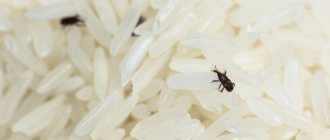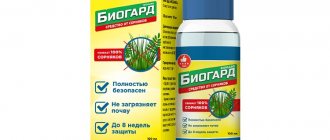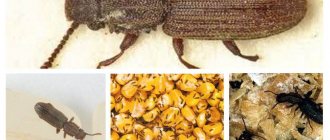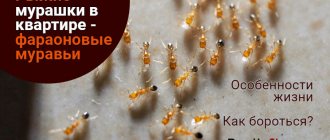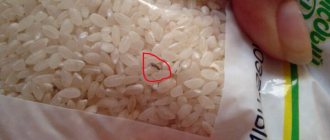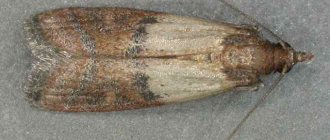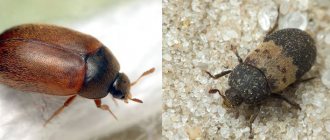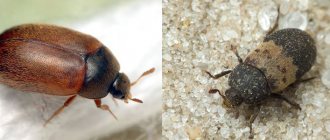Description of pests
To choose effective methods and means to get rid of food bugs in the cupboard, you need to know what different types of insects look like. The Suriname mucoed beetle is a small brown beetle. A common species found in all regions of the country. In the northern regions, adult individuals settle in a warm room, in the south in a cool one. Lives in grains, products, flour, cereals, seeds, nuts, candied fruits, dried vegetables, confectionery, and bakery products.
The red flour beetle is a small insect of rust color with a golden tint.
Distributed from the southern and central zones of the Russian Federation. It feeds on grains, cereals, flour, and corn. Moves into rooms with a disturbed microclimate (high humidity). The small mealworm is a small red or brown beetle. Color can vary from light to dark tones. It is more common in the central part of Russia, but is distributed everywhere. Flour is the first to be attacked by insects, then it contaminates cereals, bran, dried vegetables, and fruits. Does not eat legumes or whole grains.
The bread borer is a small brown beetle with a hood-like front back. One of the most common species in the Russian Federation, it inhabits warm apartments and residential buildings. It feeds on absolutely everything edible and makes numerous movements in foods. It also damages medicinal plants and pharmaceutical preparations (tablets, bags of powder, herbal preparations). Eating contaminated foods is hazardous to health.
The rice weevil is a small dark brown beetle with an elongated head. In Russia it is found in the southern regions. Damages grain, flour, cereals (rice, pearl barley, barley), seeds, dry bakery products (crackers, crackers, crispbread, biscuits, cookies).
How insects get into the kitchen
Maintaining the sanitary and hygienic condition of the kitchen at the proper level does not guarantee against the appearance of pests.
Bugs get into the house with store-bought products. The risk of bringing in insects increases when purchasing cereals, flour, and pasta by weight. Closed packaging does not guarantee the absence of bugs. Therefore, before you buy crumbly products, you need to inspect them. Even if adult individuals are not visible, there are signs indicating their presence - lumps, cobwebs, powdered grains, larvae.
Infected products with the proliferation of pests lose their organoleptic properties. There is a characteristic smell of dampness and a bitter taste.
Some beetles tolerate field conditions well, fly actively and enter homes through windows, doorways, cracks, and supply and exhaust ventilation. Some species can get into the house when buying antiques or old furniture made from natural wood.
In what places do bugs most often accumulate:
- cereals, flour, beans, spices;
- dried fruits, candied fruits, dried vegetables and fruits, nuts;
- coffee Tea;
- raw vegetables stored not in the refrigerator, but in the cupboard;
- medicines, herbal preparations, herbarium;
- behind the walls of furniture, in crevices;
- in boxes for storing food (bread, cookies);
- on the floor along the baseboards;
- kitchen appliances (meat grinders, coffee grinders, blenders, dough kneaders, food processors).
Where do bugs in cereals and larvae come from?
In most cases, the insect or its larva gets in with poor quality cereals purchased by weight. However, it is not uncommon for beetle eggs to be found in vacuum packaging, if we are talking about unscrupulous manufacturers who violate the sanitary regime for storing cereals in factories and warehouses.
Read more ► How to deal with wax moths in hives
Infection can occur in recently purchased cereals due to improper proximity, when prunes, pasta, flour, tea, coffee, and spices are stored nearby.
People's tips for exterminating insects
There are many life hacks on how to get rid of flour bugs in your kitchen cupboard.
If you find pests, audit your supplies. Spoiled products are not suitable for further consumption. They need to be placed in plastic bags, tightly closed and thrown into a trash can outside. Then they begin to inspect the bedside tables. Drawers are removed. Suitable products and indoor plants are removed from the premises. They go through the entire kitchen with a vacuum cleaner.
Furniture is treated with chemicals for home use - aerosol preparations in cans (Dichlorvos), aquafumigator. Spraying is carried out with the window open for ventilation. Instead of drugs, liquid aggressive media are used - bleach, chlorine-containing cleaning gels, a solution of potassium permanganate, boric acid.
After treatment, close the window and doors and leave the kitchen for 2 hours. This time is enough for the pests and larvae to die. Before washing everything, ventilate the room for 20 minutes and begin cleaning. Wipe the shelves and walls of bedside tables with soda or soap solution (you can use dishwashing detergent). Then they go through it again with clean water and a rag. Leave to dry. Containers and cereal storage containers are thoroughly washed.
At the end of cleaning, food, dishes, and other items are brought in. It is recommended to set up mechanical traps for food bugs. These are affordable devices that will help exterminate the remaining individuals.
How to get bugs out of your kitchen cabinet
You can fight beetles in cereals, but only if the degree of damage is minimal. If insects are quickly detected in oatmeal and other products, it is necessary to eliminate heavily damaged areas, pour the rest of the product onto a clean baking sheet and calcinate well at a temperature of at least 110 degrees. The flour must first be sifted through a fine sieve.
It doesn’t make sense to remove bugs from cereals in large numbers; it’s easier to throw away spoiled products.
But eliminating the threat from the product is half the battle; newly arrived food products can be excellent options for lurking pests.
Fighting bugs in the kitchen
Tips for disinfecting your closet are:
- To prevent the black bugs from returning again, all contaminated containers must be thrown away. This applies to bags, packages, bags.
- After eliminating pests, glass jars are washed well in a soap solution with the addition of soda ash. Rinsing and good drying are required.
- It is better to store cereals in which no pests have been found in the freezer for the next couple of weeks.
- The disinfectant for cabinets is prepared from laundry soap and vinegar. All surfaces are thoroughly wiped with it, and boiling water is poured into the cracks.
Insecticidal treatment from specialists
Calling a professional pest control service is necessary when the number of insects is rapidly increasing, and you do not know how to get rid of the bugs in the closet on your own.
The population settles not only in furniture, but also behind baseboards, in the joints of walls and wallpaper, tiles, gaps, and ventilation ducts. Treatment with modern certified insecticides is a safe procedure. In residential areas, the cold fog technique is used - converting a liquid insecticide into a gaseous substance. The master makes a working solution from the concentrate, pours it into a generator, which emits a fine aerosol. This form allows the product to easily penetrate hard-to-reach places. The drug does not damage kitchen furniture or damage household appliances. After settling and drying, it does not emit toxic volatile substances.
Advantages of cold fog treatment:
- complete chemical safety for people and pets;
- absence of a specific pungent odor or toxic fumes;
- maintaining the activity of the drug for up to 6-8 weeks;
- there is no need to leave the home during treatment (residents may remain as long as they wear personal protective equipment).
After disinfestation, general cleaning is not required. The sprayed product settles on the surface, dries and continues to act for up to 1.5 months. The concentration of the dried solution is insufficient to cause poisoning in humans or pets if it comes into contact with the skin, mucous membranes, or fur.
Is it possible to eat contaminated foods?
The generally accepted opinion is that if you sort the grains or sift the flour, they can be safely consumed.
Moreover, they are subject to heat treatment. This is one of the misconceptions. Most insects live in contaminated foods. There is often a hidden fungus there, or bread mold in the flour. Even after baking in the oven, bakery and confectionery products pose a threat. Once in the body, the fungus causes severe chronic diseases of internal organs that are not diagnosed at an early stage. People turn to doctors with advanced forms of the disease. Therefore, it is strictly prohibited to use contaminated flour.
As for cereals, expert opinions are divided. They can be sorted and subjected to heat treatment - heated in the oven at 50-60°C. Also, beetles and larvae die if the cereal is placed in a freezer with a temperature range of -5 to -11°C for at least 2 weeks.
How do they get into the house?
You buy bugs. They don't start on their own and don't fly off the street. Typically, insects come with loose cereals, which are cheaper than packaged ones.
But they can also be in sealed packaging. Therefore, watch what you take. Although, to be fair, usually “sold” are larvae that cannot be seen.
Storage rules
To store cereals, containers made of different materials are used - polyethylene, thick plastic, glass, ceramics.
Some housewives sew bags from cotton fabric. In them, grains, pasta, and flour are stored for a long time due to the penetration of oxygen. Products do not rot or spoil due to the proliferation of mold fungi. To prevent insect infestation, the bags can be boiled for 5 minutes in salt water and dried. If the container is purchased in a store, it must have special openings to ensure air ventilation inside. The lid must be screwed or slammed shut.
Plastic bags for storing cereals should also have micro holes to allow air to circulate. It will be a plus if the bag has a special reusable fastener (Zip-Lock). Glass and tin jars should also be tightly closed so that beetles do not get inside through the gaps.
The kitchen must maintain a constant microclimate. The optimal temperature range is from 18 to 22°C. It is not advisable for the air temperature to rise above 25°C. If there is no air conditioning in the room, during the summer season it is better to store cereals in the refrigerator at a standard temperature of 2-6°C. This approach will prevent not only the appearance of insects, but also fungi, mold, and other harmful microorganisms, and there will be no need to get rid of bugs in the kitchen cabinet in the future.
If you're storing large amounts of food and are worried about insects ruining it, there are tips to help you avoid this. Cereals such as rice, buckwheat, and millet can be calcined in the oven. The kernels are poured in a thin layer onto a baking sheet and placed in an oven preheated to 80°C for 2-3 minutes. Heat treatment will destroy invisible contaminants (larvae, eggs, spores).
The method is not applicable to flour, since it contains gluten. The protein structure of the substance collapses at temperatures above 50°C. It is impossible to knead normal dough from such flour. It will spread, blur, and will not gain elasticity. The baked goods will not rise and become loose.
The oxygen contained in the atmosphere plays both a positive and negative role. On the one hand, it is necessary for normal preservation and prevention of mustiness. On the other hand, during long-term storage, oxidative processes begin, which creates favorable conditions for the colonization of beetles. Ground grains are the most vulnerable. Therefore, it is important to adhere to the specified shelf life of the product.
The main reasons for the appearance
Note that you run the risk of finding bugs not only in stale cereals. At risk:
- cookie;
- flour;
- bread;
- vegetables;
- fresh fruits;
- tea and coffee;
- spices;
- legumes;
- dried fruits;
- sugar;
- food concentrates;
- bread.
Many people do not suspect, but people buy harmful insects themselves. More often, “stuffed” semi-finished products are sold not in individual packaging, but by weight. By purchasing cereal packaged by the manufacturer, you risk introducing parasites into your kitchen. Sometimes they cannot be seen because they are in the larval stage.
You should not make large stocks of bulk products. Shop as needed. Otherwise, you will also add months in your home to the shelf life of the goods in the warehouse. Sometimes it exceeds the norm several times. And the probability of pests appearing under these conditions is close to 100%.
Preventive measures
To get rid of insects in closets forever and prevent them from appearing, there are simple recommendations:
- do not buy large stocks of products, store them no longer than the indicated expiration date;
- monitor the integrity of the packaging of cereals and flour; if possible, it is better to pour them into special sealed containers for storage;
- keep the cabinet clean, do not allow spilled grains or crumbs of flour products to become heated;
- regularly ventilate kitchen furniture, maintain the microclimate, provide supply and exhaust ventilation;
- do not buy food at spontaneous markets, unequipped points of sale, as well as in stores where bulk products are sold by weight.
As repellents, you can place lemon peel, chestnuts, table salt, lavender, and bay leaves in the nightstand.
They do not emit a specific odor and do not affect the organoleptic properties of products. To prevent insects from laying eggs and developing larvae, the shelves can be wiped with a weak vinegar solution once every 1-2 weeks. To prevent mustiness and unpleasant odors, use hot pepper (preferably red). At the bottom of the jars you can put a small bag filled with salt, starch, zest, and chopped bay leaf. Tin and glass containers are wrapped in foil paper.
By following these simple steps, you can easily get rid of ants in the closet and create unfavorable conditions for their appearance.
Ways to fight
There are various ways to get rid of pests, each homeowner can choose the appropriate one. You need to do a number of things first. Go through all bulk products and identify the source of contamination and affected packages. All provisions need to be checked, even if this type of food is not typical for beetles. If there are bugs in the cereal, then we get rid of it immediately, if there are bugs in the flour, then get rid of the flour, etc. Everything should be thrown into the trash immediately.
You should carry out general cleaning without missing a single detail. They wash all food containers, cabinets, furniture, household appliances, radiators, floors and window sills. It should be remembered that a colony can be anywhere.
On a note!
To wash containers, use soda; for the rest, dilute vinegar and use standard cleaning products.
It is better to block access to all joints and gaps in the apartment. Bulk products are poured into sealed containers and not used for 2 weeks. During this time, it will become clear whether the food is affected or not.
